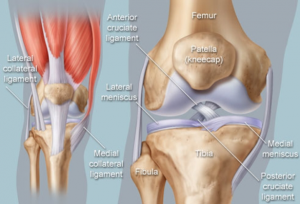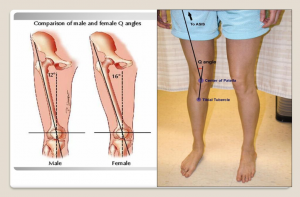
4 Things to Help Reduce Risk of ACL Tears
ACL tears have been plaguing athletics for quite some time. Over the past 30 years, high school sports participation has increased, and ACL injuries have skyrocketed as a result. Each year, somewhere between 100,000-200,000 athletes in the United States suffer this devastating injury. Anyone who’s been through it will likely tell you the aftermath is worse than the injury itself. This aftermath includes the emotional toll, costly surgical repair, long rehabilitation process, missing out on social life, impatience and agitation, and the list goes on.
What Causes ACL Tears?
The knee joint is a complicated arrangement of bones, ligaments, and muscle tendons. Ligaments are connective tissues that attach bones to other bones and secure structures together for stability. There are four major ligaments that work together to provide knee stability.

1- Medial Collateral Ligament (MCL)
2- Lateral Collateral Ligament (LCL)
The MCL and LCL help limit unwanted side-to-side motion.
3- Anterior Cruciate Ligament (ACL) – Most commonly injured
4- Posterior Cruciate Ligament (PCL)
The ACL and PCL help prevent anterior and posterior (front to back) displacement of the femur bone or the tibia bone.
The ACL is most vulnerable during rapid explosive movements. Athletes are seven times more likely to sustain an ACL injury in competition than in practice. Live competition is a fast, unpredictable environment. Athletes undergo repeated bouts of vigorous motions and they need to be ready for the demands placed on their body. The majority of ACL tears are a result of an uncontrolled non-contact movement, such as when an athlete is changing direction, decelerating, or pivoting. If high levels of force are produced and the athlete does not possess the ability to control and absorb that force, the potential for injury increases. ACL tears are very common in soccer, football, basketball, skiing and other sports where stop-and-go movements are required. The good news is strength and conditioning can help athletes enhance body control and the ability to absorb these unpredictable forces, which lowers their risk.
Is It True Female Athletes Are at Higher Risk?
Yes, female athletes are thought to be at higher risk for a few reasons. This is largely due to anatomical differences like wider “Q-angles” (quadriceps angle). Having wider Q angles leads to more valgus collapse (knees buckling inward) during explosive movements. Knee valgus places strain on the ACL, making it harder to keep the knee stable. Another risk factor we tend to see more in females is “quad dominance.” Meaning their quadriceps/hamstrings strength ratio is often imbalanced. Athletes who are quad dominant rely on their quadriceps to decelerate, change direction and/or re-accelerate, when those movements are meant to be accomplished through the hamstrings.

What Can Be Done to Help Prevent ACL Tears?
To help reduce ACL injury risk, young athletes should get involved in strength and conditioning programs where proprioception, deceleration technique, core strengthening, and posterior chain strengthening are emphasized. When programming for athletes, it’s important for strength coaches to consider the “joint-by-joint” approach, which was introduced by physical therapist Gray Cook and renowned strength coach Mike Boyle. The joint-by-joint approach stresses the importance of considering “the whole” as opposed to isolated body part training.

The photo illustrates the human body as a stacked pile of joints which all have different needs. When starting from the bottom and working up, you will see a mobile->stable->mobile->stable->mobile->stable pattern. If any segment of the chain is dysfunctional, it will likely have an adverse effect on the joints above and below. For instance, if one of my clients is experiencing knee pain when squatting, it would be wrong of me to assume that his/her knees are the problem. Instead, I will test his/her ankle mobility and examine hip function.
Emphasize These Four Training Components
We can help reduce the risk of suffering ACL injuries if these four training components are prioritized and implemented appropriately.
1 – Proprioception Training (Single Leg Balance)
We train balance because there aren’t many instances when an athlete is on two legs at the same time. Single leg balance training on unstable surfaces can improve hamstring strength and other stabilizers of the ankle, knee and hip joints. Balance drills force the central nervous system to quickly re-adjust body orientation and enhances overall neuromuscular control. When communication between the central nervous system and the body improves through balance training, athletes have more control and awareness of their body.
Here are some video examples of balance drills –
2 – Deceleration and change of direction training
This is something that is sadly rare for young athletes to ever be taught. If a sports car has brake issues but the owner has ignored the signs for quite some time, something is going to give out eventually. The human body is no different. To keep the knees healthy, athletes need to learn how to properly absorb the force they produce. The hamstrings and other muscles of the posterior chain function as the body’s brakes and if the brakes aren’t activating properly, an athlete’s risk of injury is greatly increased.
Here are some video examples of deceleration drills –
3 – Posterior chain training
The posterior chain muscles we need to strengthen here are the glutes, hamstrings and calves. As previously mentioned, many athletes are quad-dominant and the quadriceps are anterior chain. The more we strengthen the posterior chain, the easier learning how to decelerate becomes.
Here are some video examples of posterior chain strengtheninig exercises –
4 – Core Training
The core is where all strength and control is generated. It protects the spine and restricts unwanted movement. Individuals who don’t use the joint-by-joint approach may overlook core training in the prevention of ACL injuries due to its distance from the knee, however, the validity of this approach holds firm that the body moves as one and if one segment is lacking, the system will break down somewhere. The glutes and pelvic stabilizers are indeed core muscles and aid in protecting all things above and below.
Here are some video examples of some great core exercises for athletes –
Michael has been a strength coach at Olympia Fitness and Performance for three years. Michael graduated from Rhode Island College where he studied Community Health & Wellness with a concentration in Wellness & Movement studies. After graduating, Mike went on to get his CSCS (certified strength and conditioning specialist) through the NSCA. He is also a Certified Speed and Agility Coach, as well as a TPI certified coach. In his three years as a strength coach, Mike has helped clients from all walks of life improve their fitness levels. He has a strong passion for helping young athletes not just improve their athletic performance, but also helping them build confidence.
References
- Pfeiffer, Ronald. Mangus, Brent. Trowbridge. Cynthia. Concepts of Athletic Training 7th Jones & Bartlett Learning. 2015.
- Anterior Cruciate Ligament (ACL) Injuries. Orthoinfo – American Academy of Orthopedic Surgeons. (2018, March 23). https://orthoinfo.aaos.org/en/diseases–conditions/anterior-cruciate-ligament
- Boyle, Mike. (2007, April 12). A Joint-by-joint Approach to Training. StrengthCoach.com. https://www.strengthcoach.com/public/1282.cfm

